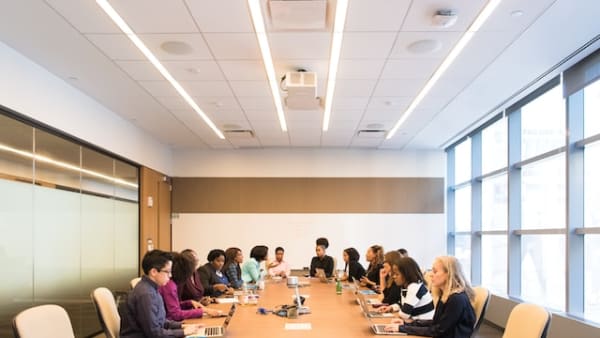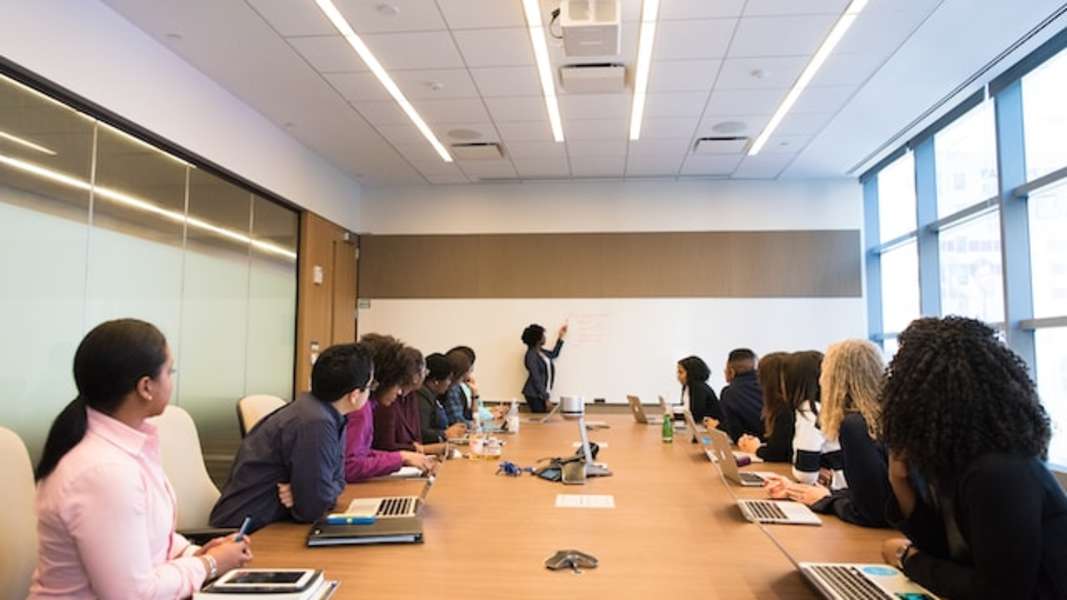
What Is An All Hands Meeting?
April 11, 2023

What is an all hands meeting?
An all hands meeting is a company-wide event that includes all employees, from executives to entry-level staff. The purpose of an all hands meeting is to discuss important topics, share updates, and promote transparency and alignment within the organization.
All hands meetings are usually held on a regular basis, such as monthly or quarterly, and are typically led by senior management. The meeting agenda may include presentations, Q&A sessions, and team-building activities.
The key difference between an all hands meeting and other types of meetings is the scope of attendees. While other meetings may be limited to specific teams or departments, an all hands meeting involves the entire company.
They also have a more formal agenda, with specific topics and time slots allocated for each item.
Why are all hands meetings important?
All hands meetings facilitate the dissemination of critical information - such as an organization's goals, priorities, and progress - ensuring all employees are on the same page. At the same time, they provide an opportunity for senior leadership to directly communicate with the workforce, address any concerns and answer questions, which can enhance trust and respect.
All hands meetings also provide an opportunity for company-wide recognition of high-performing employees. This brings a boost to morale and encourages team members to continue contributing to the success of the organization.
Finally, all hands meetings offer a platform for open discussions on any pertinent matters affecting the organization, encouraging collaboration and fostering a sense of ownership among its employees.
When to hold an all hands meeting
All hands meetings can perform a variety of functions. Whilst they’re typically recurring meetings held at regular intervals, they can also act as stand-alone events. Some common reasons to hold an all hands meeting include:
Quarterly or annual updates: many companies hold all hands meetings on a quarterly or annual basis to provide updates on the company's performance, goals, and strategy.
Major announcements: all hands meetings can also be held to announce major news within the organization, such as a merger or new leadership appointment, or as part of a change management plan.
Celebrating milestones or achievements: all hands meetings can be a great way to celebrate company milestones, such as reaching a revenue target, launching a successful product, or winning an industry award. They can also be used to recognize employee achievements, such as promotions, work anniversaries, or completion of a major project.
Training and development: all hands meetings can also be used to provide training and development opportunities for employees. This can include workshops on topics such as leadership development, diversity and inclusion, or technical skills.
When determining the frequency of all hands meetings, it's important to consider the needs of the organization and the employees.
Quarterly or annual all hands meetings are common, but the frequency may vary depending on the size and complexity of the business. Some companies may hold more frequent all hands meetings - such as monthly or bi-monthly - to ensure that employees remain informed and engaged.
Planning an all hands meeting
By their nature, all hands meetings require a lot of planning. Organizers need to ensure all stakeholders are able to attend, that things run smoothly on the day, and that the event itself is productive.
Here are some key steps for all hands meeting preparation:
1. Establish objectives: clearly define the objectives of the all hands meeting. Is it to share updates, recognize achievements, or facilitate team building? Understanding the purpose will guide the agenda and activities.
2. Choose a date and time: consider the availability of all employees and select a date and time that works for most, avoiding conflicts as much as possible. It's also important to consider things like the availability of meeting space and the potential impact on productivity. Some companies may opt to hold virtual all hands meetings to make attendance more convenient and cost-effective, especially in the case of remote or distributed teams.
3. Create an agenda: craft a detailed agenda that includes the meeting's purpose, topics to be discussed, and time allocated to each item. Be sure to provide opportunities for interactive discussions, Q&A sessions, and engagement activities. It's important to strike a balance between informative and engaging content to keep attendees interested and motivated throughout.
4. Coordinate speakers: identify speakers who can effectively deliver the meeting's content. This may include executives, team leaders, or guest speakers. Coordinate with them in advance and provide guidance on the agenda and expected outcomes.
5. Prepare materials: gather and prepare any relevant materials, such as presentations, reports, and handouts, to support the meeting's content. Share these materials with attendees beforehand for review.
6. Test technology: if the all hands meeting is conducted virtually, ensure that the necessary technology, such as video conferencing tools, is tested and working smoothly prior to the event. Provide instructions and support to employees to join the virtual meeting.
Conducting an all hands meeting
Whilst the planning stages of an all hands meeting are critical to a successful event, so too is the way the meeting is conducted:
1. Start with an icebreaker: kicking things off with an icebreaker activity can help create a relaxed feel and a positive and engaging atmosphere. This can be a fun question, a team-building exercise, or a brief game.
2. Introduce the agenda: before diving into the content of the meeting, introduce the agenda and provide an overview of what attendees can expect. This will help to set expectations and keep the meeting on track.
3. Engage the audience: keep the audience engaged throughout the meeting by asking questions, encouraging participation, and using storytelling techniques to convey information.
4. Facilitate Q&As and feedback: encourage attendees to ask questions and provide feedback during the meeting. To facilitate this, designate a Q&A period after each section of the agenda, or use a Q&A platform that allows attendees to submit questions and feedback anonymously.
5. Stay on schedule: to ensure that the meeting stays on track, set time limits for each section of the agenda and stick to them. This will help to prevent the meeting from running over and causing attendee fatigue.
6. Use visual aids: using visual aids, such as slides or videos, can help to convey information more effectively and drive engagement. Just be sure to use visuals sparingly and only when they add value to the content being presented.
7. End with a call to action: finish off with a clear call to action that summarizes the key takeaways and outlines the next steps. This will help to ensure that attendees leave the meeting with a clear understanding of what is expected of them.
Following up after an all hands meeting
Following up after an all hands meeting helps reinforce key messages and ensures the organization moves forward with a shared understanding and commitment to the outcomes. It’s also an opportunity to learn about how the meeting was received.
The first step is to send out a summary email highlighting key takeaways, including any action items or decisions made. This email should be sent as soon as possible to ensure attendees remember the most important points and remain accountable for their contributions.
It's also a good idea to gather feedback from attendees to determine the effectiveness of the meeting. One way to do this is to send out a survey that asks them to rate various aspects, like the quality of the information presented, the level of engagement, and the overall organization.
This feedback will help identify areas where the meeting was successful and areas where improvements could be made.
Once you've gathered feedback from attendees, review it carefully to identify patterns or common themes. For example, if several people commented on the need for more interactive activities, you might consider incorporating more group exercises or creative sessions in the future.
Tips for successful all hands meetings
- Clearly define the objectives and goals of the meeting to ensure that everyone is on the same page and understands what is expected of them.
- Prioritize engagement and interaction to ensure attendees remain attentive and focused throughout the meeting. This can include interactive elements such as Q&As, team-building activities and visual aids.
- Keep the meeting concise and to the point. Avoid unnecessary information and tangents that may distract from its main objectives.
- Encourage participation from all attendees and give everyone a chance to share their thoughts and contribute to the discussion. This can be done through interactive elements, such as Q&As and collaborative sessions.
- Follow up on action items assigned during the meeting and make sure they’re completed on time. This will keep everyone accountable and ensure the objectives of the meeting are met.
Final thoughts
An all hands meeting is an important communication tool for organizations to connect with their employees, align everyone with company goals, and ensure all staff are working towards a common purpose.
To make the most of an all hands meeting, it's important to carefully plan and prepare the agenda, encourage participation, and follow up after the meeting to ensure ongoing commitment to objectives.
By following these best practices, organizations can effectively leverage all hands meetings to improve communication, increase employee engagement and achieve business objectives.
Boost your hiring power.
Start using Neuroworx today.
Talk is cheap. We offer a 14-day free trial so you can see our platform for yourselves.
Try for free




